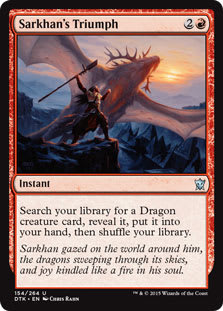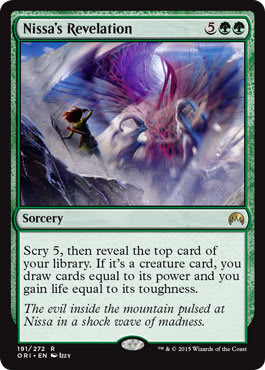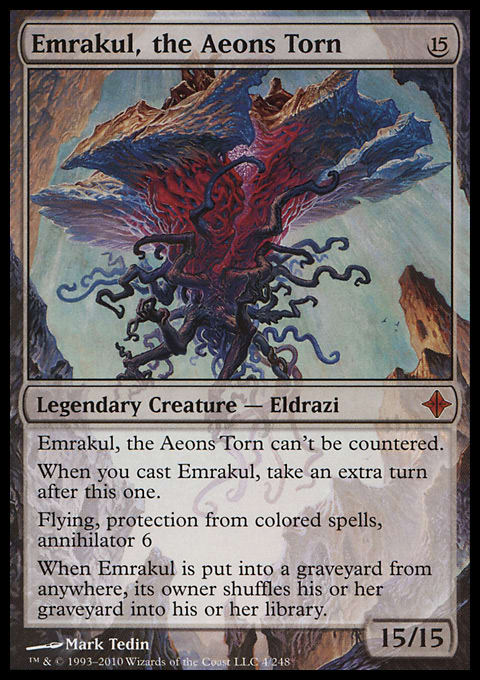Every game of Magic tells a story. In one duel, you could find yourself playing the archenemy, casting Villainous Wealth on your pitiful opponent and asserting your dominance as the greatest evil in the Multiverse. The following game could depict an entirely different narrative, your attempt at procuring wealth thwarted by your rival’s Force of Will.
 |  |
Speaking from experience, having a massive Villainous Wealth be countered by a Force of Will is definitely a memorable gameplay moment. Though I’m sure the caster of that Force of Will and I have vastly different feelings about that memory . . . | |
Parallel to our own stories experienced through the flavors of Magic are epic storylines revolving around established characters and their own struggles as they adventure throughout the Multiverse. Through the cards, we are able to share in their journeys, enabling us to know what it would be like to take down a vengeful deity or restore a world to its former splendor.
Every once in a while, the stars seem to align. The Vorthos gods look down on our game states with the utmost favor, creating situations in which the cards we play so perfectly line up with established storylines that it feels as though we are reliving exact moments in Magic’s glorious history.

After doing some digging, as well as discussing the idea with both Shawn Main and Ari Levitch of Wizards of the Coast, it has come to my attention that these types of card interactions are no accident and are in fact planted into Magic by the Wizards creative team. What really struck me by that simple fact was that we had the creative team to thank for these moments. I think that needs to change. It is my opinion that creating moments that further the story’s narrative through gameplay is an untapped resource in Magic design, and with today’s article, I would like to explain three key reasons why. Today, I present to you an article on narrative design and why I think it can be an important tool for designing Magic sets.
One: Immersion
Immersion as a term is thrown around a lot by gamers in general, but what exactly does that mean? What am I trying to say when I tell you that a game is creating a sense of immersion? There is a fantastic article on immersion (or the creation of spatial presence) in games that can greatly help you understand what an immersive experience is. If you are interested in gaming psychology, it’s definitely worth a read. For those of you who don’t feel like delving into a psychological article, immersion is the process of allowing the fantasy world to take over your senses while you play a game. It’s what allows your mind to believe that fighting dragons with a warhammer makes sense. The easiest way to achieve this in your audience as a game designer is to influence events within your game world that make it feel as though it is a living and breathing thing. In videogames, a sense of immersion can be imparted onto gamers through the environment by allowing players to interact with literally everything around them (think Skyrim) or by having the NPCs follow varying scheduled depending on the day—creating the illusion that they are going about their lives even when the players are not interacting with them (Majora’s Mask did this exceptionally well).

Image found here
It should be no surprise that Magic is also capable of creating a sense of immersion. One method that Mike and I often discuss on Snack Time with Mike and Ant is when Wizards releases a supplementary product that offers a peek at a world we visited in the past. By showing us a glimpse of the different cultures we already know (and showing how they have changed since we last saw them), Wizards creates the illusion that even while the spotlight isn’t on a particular plane, it is still a living, breathing, evolving world.
But what happens when the creative team decides to introduce a new a completely new plane into the fold? The Planeswalker's Guides and Uncharted Realms articles provide an easy way to inform players of the next plane they are about to planeswalk to. This insider information helps prepare players to start imagining the world in their mind's eyes, establishing the plane as a concrete location with its own unique cultures and planar metaphysics. For players who may not read those articles on the mothership, the process is a bit slower. With each new card they see, with each new name and line of flavor text, they start to create the world in their imaginations using information provided by the cards for themselves and then fill in the gaps with their own assumptions based on knowledge and past experiences. Once the player has accepted the world and is experiencing immersion, they start receiving payoffs. For them, playing Magic feels like reading a comic book or watching a movie, each turn a new chapter in an ongoing story depicting a rivalry between two (or more) powerful Planeswalkers.

But what if a player is new, hasn’t read any articles about the plane online, and only reads flavor text when he or she is bored? This is where creating narrative design elements within the game can present an interesting opportunity in that it helps a player establish a good sense of the world he or she is exploring without forcing him or her to do anything that he or she would not otherwise do when playing the game. Top-down design does a great job of tackling this on an individual, card-by-card basis, but it starts to fall apart when the cards begin interacting in ways that do not make sense in the world you are trying to establish. This is where narrative design can pick up the pieces, serving as a fantastic way to accomplish immersion across multiple cards.
Example: Victim of Night
Victim of Night is a fun, top-down card, but it also served an important role in helping to establish Innistrad and immerse the players in that world. Chances are that, for the majority of Limited games in which players were casting Victim of Night, the spell was targeting a Human during Innistrad block. Over the course of multiple games, players continuously witnessed the fall of a Human to the card, replaying the common narrative that “humans are in trouble” on this plane. That multiple-card gameplay experience helped players to establish the plane of Innistrad in their minds and furthered their immersion into its extremely flavorful setting. By working to include similar moments in the design of each new set that correctly reflect the overall narrative, Wizards can help players experience a greater sense of immersion through multiple card interactions that allow them to correctly experience the story for themselves via gameplay.

Two: Awareness
With each new plane, the creative team works tirelessly to create an expansive setting for us to visit as players, developing memorable cultures, locations, and characters for us to experience. Narrative design offers a way for players to experience these worlds and stories firsthand through actual gameplay.
As I mentioned earlier, there are going to be players who never read Uncharted Realms or the Planeswalker’s Guides to a given setting; they may not even read the flavor text found on the cards. These players may have no idea that there is a larger storyline happening at all, and they might just look at each new set as a bunch of cards with different mechanics for inclusion in one or more decks. Creating immersive gameplay interactions can help these types of players become more aware of the current setting and its overall storyline. Imagine a player (for sake of discussion, we will call her Gayle) went to the Khans of Tarkir prerelease knowing absolutely nothing about the setting. Gayle sits down against her first opponent who happens to be a diehard Vorthos (let's call him Will). Over the course of the game, Gayle plays a Surrak Dragonclaw and targets him with a Savage Punch targeting Will’s Alpine Grizzly. Will, being the astute Vorthos that he is, recognizes that the play is straight out of the actual story and explains to Gayle why the interaction is dripping with relevant flavor. Gayle thinks that’s awesome and decides to read more about this Surrak character and his clan on the main Magic website.

This is just one example of how a narrative gameplay string can create awareness for a player who was unaware of the story elements involved. The trouble with this example is that it is extremely rare for the interaction to actually happen in a game of Limited Magic. This is where dialogue between the design and creative teams is super-important.
What if it were recognized during Khans design that this interaction could be a strong immersive narrative moment that should be repeated? The creative team could have decided that all members of the Temur clan had to embark on a coming-of-age ritual in which male and female warriors would venture into the bear-filled wilds, find a grizzly, and best it in hand-to-hand combat. Making that single change allows a player to cast savage punch on any Temur-aligned Human in the set, target any Bear in the set, and still be one hundred percent in line with the narrative. This would allow a larger number of players to more easily experience the same emotional response to the in-game flavor, bringing the story into the spotlight through gameplay—sparking flavor-relevant discussions in game stores and at kitchen tables.

Reason Three: Enjoyment
The third and final reason I believe including narrative gameplay moments as part of Magic design is simple: It’s fun! When you target Archangel of Tithes with Unholy Hunger, it feels so good it almost feels like cheating. Why is that?

Why does finding Emrakul, the Aeons Torn with Nissa's Revelation make you smile?
Why does transforming Chandra, Fire of Kaladesh into Chandra, Roaring Flame using Chandra's Ignition feel better than using, oh I don’t know, anything else?

The answer lies in the narrative being told by the cards themselves, one that is dripping with canon flavor that triggers an emotional response in the player.
When you play a game of Magic, you are automatically creating a narrative out of the cards that you cast. No matter what you put in your deck, there is going to be a story worth telling once a player is reduced to 0 life. When the narrative actually matches up, card for card, to do something that you know actually took place in Magic’s storyline, it feels like having your cake and eating it, too. Players recognize that these events are not going to happen every game—there are just too many variables at play. When they do, they can feel absolutely amazing and evoke an emotional response that leaves the gameplay moment as one to be remembered—and shared with your friends . . .
Sean: Why is using Unholy Hunger on an Archangel of Tithes any cooler that using a Reave Soul?
Emily: Don’t you know? Ever wonder where Liliana got that headpiece she is always wearing? . . .
Or shared on social media . . .


The fact is that players really enjoy experiencing these narrative moments in game. Why not create a beautiful marriage between creative and design by building these narrative gameplay moments into the Limited environment? It's one thing to read about some badass character punching a bear. It’s another thing entirely to actually punch one for yourself.
TL;DR
I believe that narrative design is a vitally important tool for Magic design due to the following three reasons:
- It helps create a greater sense of immersion into the planes and storyline depicted on the cards.
- It helps to create further awareness of the story for players who might not be diehard Vorthoses following every Uncharted Realms article.
- It’s fun.
What do you all think? Should the design team work to create more narrative card interactions in future sets, allowing you to better experience the story through gameplay in a Limited environment? Am I completely wrong in thinking this is a powerful tool? Let me know in the comments!
Until next time, may Magic lead you to experiencing some epic narratives.
<3 Ant




























